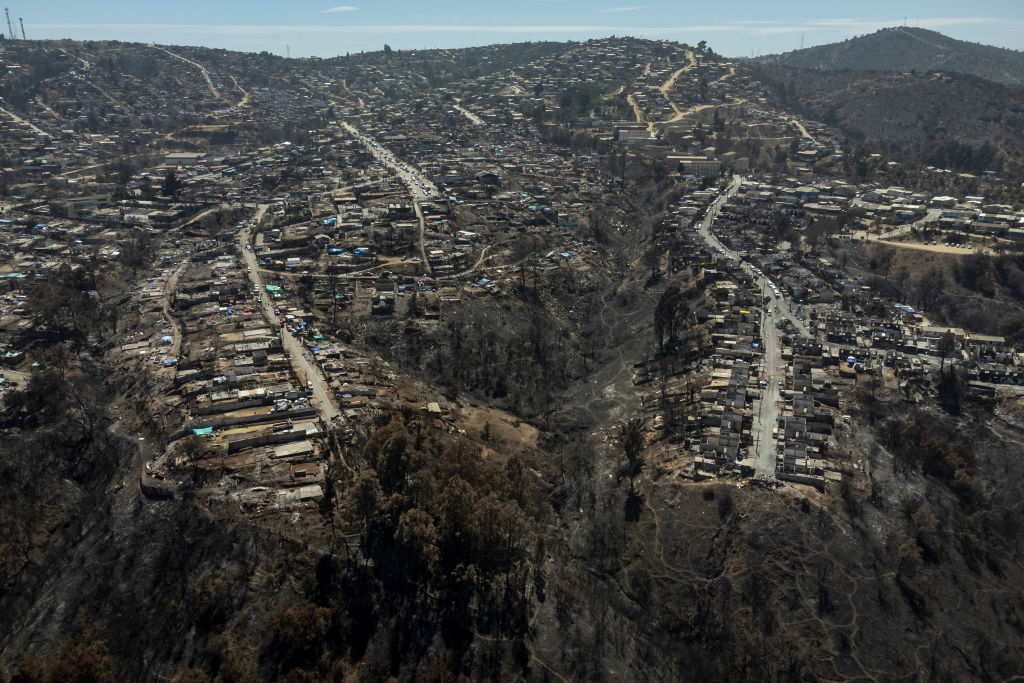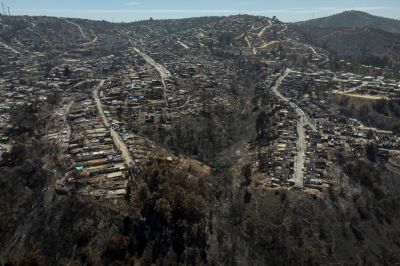Once the stuff of science fiction, the prospect of advanced energy weapons like lasers being used in conventional military operations is fast becoming a reality. Nations around the world—with the help of leading defense contractors—are pouring billions of dollars into the development of directed energy weapons (DEW), which could bring benefits such as cheaper missile defense systems and instantaneous nonlethal effects.
The evolution of DEW technology, however, has also prompted conspiracy theories about their origins, purpose, and use.
A video with more than 20 million views on X (formerly Twitter) claims that people in Chile, where devastating fires have raged this month, are now painting their roofs blue to protect themselves from the effects of DEWs.
Similar conspiracy theories regarding DEWs—including the claim that the color blue is protection against them—hit the U.S. mainstream after wildfires devastated parts of Maui in August 2023.
The fires were started, so the theories go, as part of a land grab orchestrated by either elites or the government itself. A number of videos and images claiming to show some kind of laser starting the massive fires went viral on social media platforms, though these claims were quickly debunked—most were either edited or depicted unrelated events—by news outlets such as the Associated Press and the BBC.
Even when the flames stopped, the conspiracy theories continued. New claims emerged that the fires spared blue items. One prominent post showed both a blue car and a set of blue umbrellas that had survived the flames, and another demonstrated a laser burning items of every color except for blue.
The claim that blue objects are resistant to DEWs and survived the Maui fires is false. The AP determined in an August 2023 story that color had not influenced what was destroyed in the Maui fires, and many photos of the devastation show houses and items of other colors that were also spared. “Fires like the Maui fire often leave unburned items for no apparent reason. Fires are stochastic this way,” Peter Sunderland, a professor of fire protection engineering at the University of Maryland, told The Dispatch Fact Check.
Likewise, the idea that the color blue could counteract a powerful electronic weapon does not stand up to scientific scrutiny. “There are countermeasures that you could take to improve your defenses against a directed energy weapon if you were military that was fighting an enemy that had those sorts of systems,” James Black, assistant director of defense and security at RAND Europe, told The Dispatch Fact Check. “But it’s not going to be just painting stuff blue. It’s far more sophisticated and complicated than that.”
The prominence of DEW technology in modern conspiracy theorizing doesn’t surprise analysts like Black. “I think there are a lot of traits of directed energy weapons that mean that they fit quite neatly with some kind of basic or recurring conspiratorial stories,” he explained.
For one, DEWs leverage technologies—such as laser and radio frequency weapons—the general public doesn’t know much about. “The scope for misinformation, not just disinformation, becomes quite high just because people misunderstand what is and what isn’t happening and what is realistic and what's not realistic,” Black said. Also, the fact that DEWs are often invisible to the naked eye and generally do not leave the same physical traces as a conventional weapon—such as shell or bomb fragments—makes it hard to disprove claims. “All of these things are quite convenient from a conspiracy theorist perspective, when they’re trying to craft a narrative, because it's harder to disapprove,” Black said.
Finally, there’s simply the appealing fantastical nature of DEWs that lends itself to deeper conspiracy theories. “It feeds into some of the conspiracies that exist around global governments and the use of arcane, or even alien, technologies,” Black said.
How do directed energy weapons work?
The Office of Naval Research defines DEWs as “electromagnetic systems capable of converting chemical or electrical energy to radiated energy and focusing it on a target, resulting in physical damage that degrades, neutralizes, defeats, or destroys an adversarial capability.” This includes high energy lasers, which emit photons, and high power microwaves, which emit radiofrequency waves. Kitchen microwaves—which use electromagnetic waves to excite molecules in food—are one example of simple directed energy with which people are familiar. “Obviously, the target in that case is your microwave lasagna rather than an incoming rocket or missile, but broadly similar principles apply in the sense that you’re trying to transmit energy towards a target and induce a response,” Black explained.
Modern conceptions of DEWs find much of their origin—at least in the public mind—in Ronald Reagan’s 1983 Strategic Defense Initiative (SDI), best known as “Star Wars.” The SDI program sought to create a vast network of high powered ground-based lasers and systems that could be used to augment missile interceptors to destroy incoming Soviet ballistic missiles, however, it failed to achieve many of its ambitious aims. “There's a lively debate as to how realistic a proposition that was either technologically or economically at the time,” Black said, “and clearly it wasn't a capability that was actually ever fulfilled in a meaningful way.”
Today, a renewed focus on DEW development has taken hold in countries like the U.S., United Kingdom, and Israel, particularly for projectile defense. Existing systems like the RTX (formerly Raytheon) Phalanx and Israel’s Iron Dome utilize conventional ammunition or missiles alongside advanced computer systems to track and intercept threats. These ammunition types are expensive and require dedicated manufacturing, leading to interest in energy-based systems that, in theory, could be significantly more affordable to operate because of their almost unlimited magazine depth.
DEW technology is not yet being deployed at scale on the battlefield, but militaries are investing heavily in the technology and wider use appears to be on the horizon. “It’s certainly something that is becoming a serious proposition,” Black explained. However, while the color blue may not itself be a limiting factor to the success of DEWs, there are still plenty of obstacles to their future development. “It’s really not a panacea, there are lots of enduring technical barriers to making these things work as advertised. Plus, there's some tactical and practical barriers as well,” Black emphasized.
If you have a claim you would like to see us fact check, please send us an email at factcheck@thedispatch.com. If you would like to suggest a correction to this piece or any other Dispatch article, please email corrections@thedispatch.com.







Please note that we at The Dispatch hold ourselves, our work, and our commenters to a higher standard than other places on the internet. We welcome comments that foster genuine debate or discussion—including comments critical of us or our work—but responses that include ad hominem attacks on fellow Dispatch members or are intended to stoke fear and anger may be moderated.
With your membership, you only have the ability to comment on The Morning Dispatch articles. Consider upgrading to join the conversation everywhere.